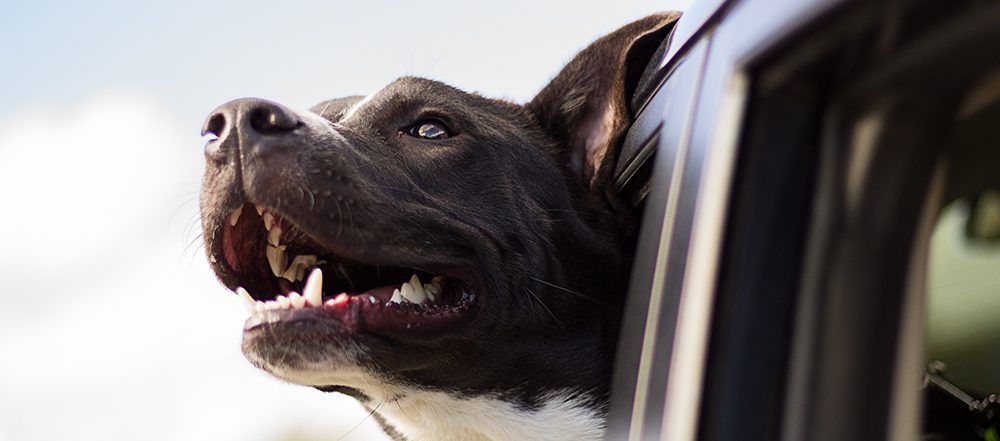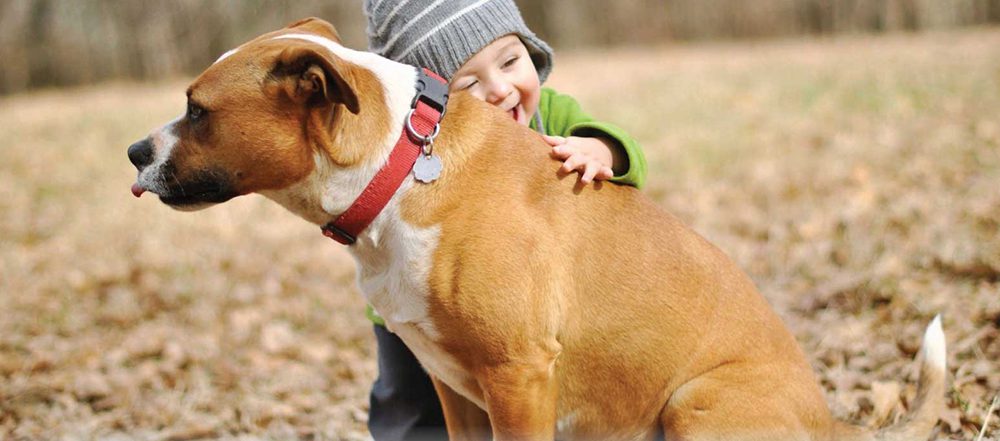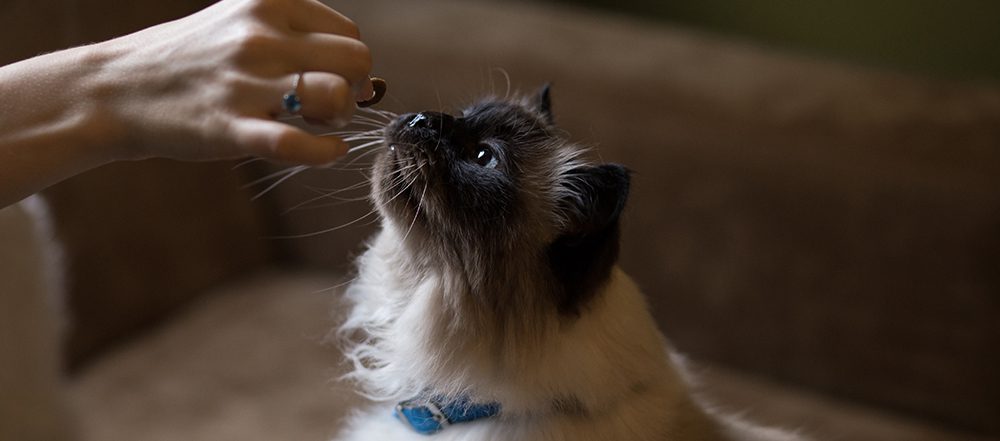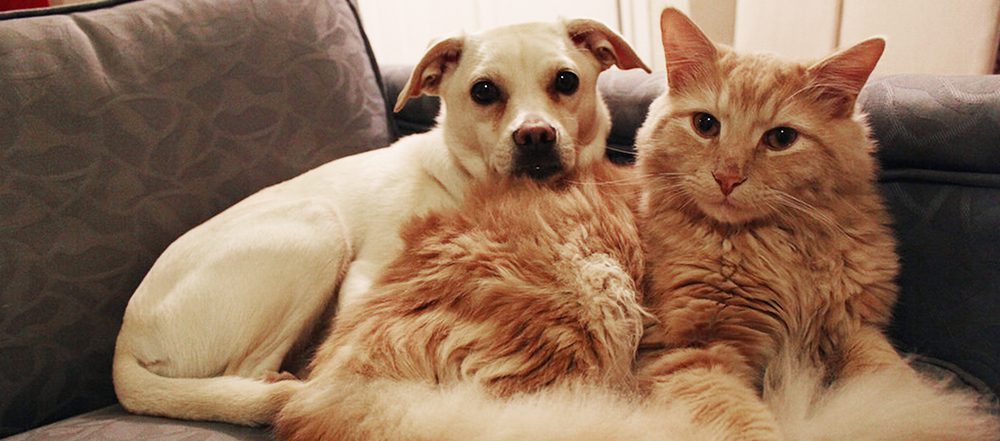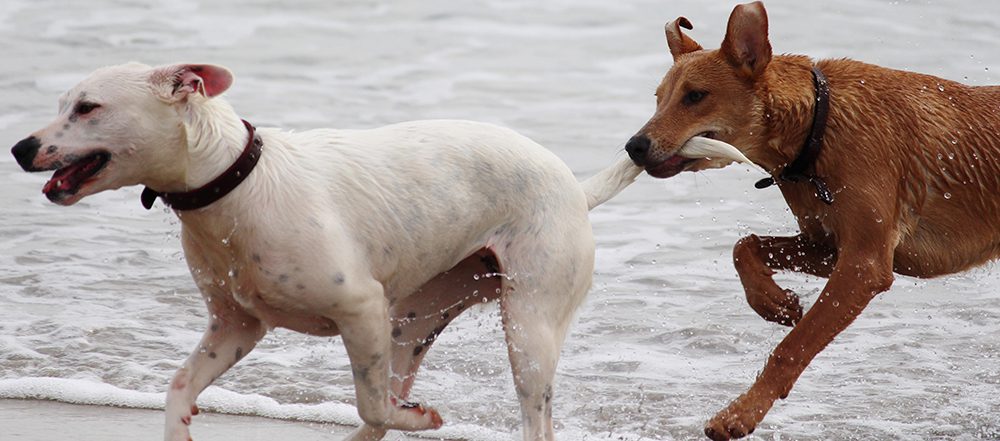Rene’s Fund
Thanks to the generosity of Rene Kurzius and Rene’s Fund, First Coast No More Homeless Pets will offer assistance so you can keep your found pet out of the shelter. Please refer to the below guide for introducing a new dog or cat to your home and family.
A New Dog in Your Home
After finding a homeless or lost pet, it is vital to introduce them to your household in a safe, comfortable way – especially if you already have pets at home.

Before Bringing the Dog into Your Home
Before you do anything, make sure you have the supplies you need, such as a leash, collar, crate, baby/dog gates, bed, food, treats, toys, flea/heartworm medication, dog shampoo, etc.
Prepare the house for your new dog by setting up the crate, bed, and feeding station. Set ground rules for the dog and decide where food, treats, medications, etc. will be stored. Make sure your house is safe by removing hazardous or valuable items that the dog could eat or chew.
You may also what to set a schedule for the dog for potty time, feeding, training, play, and walks, just so everyone in the house is on the same page.
Day One
When driving home with the dog, try to arrange for another passenger in your car so that the passenger can pay attention to the dog and prevent him/her from distracting you.
After all the needed supplies are gathered, bring the dog straight home without running additional errands on the way. When you get home, let the dog explore your outdoor area or yard on a leash, take him/her to your designated potty area and reward them with a treat if they go there. Friends and family can meet the dog in time, but for a few days you should avoid having visitors, ensuring a calm introduction for the dog to your home.
Bring the dog inside, making sure any other pets are safely locked up in a separate room or area, and give him/her a leashed tour your home. It is important to remain calm, as the dog will look to you for an example for how to act. If the dog picks up any inappropriate items, simply tell them to “leave it†in a calm, commanding tone and then offer an acceptable chew toy or treat as an alternative.
Introduce the dog to his bedding area (crate, if crate-training) and show him/her where to get fresh water. Give the dog treats early and often to encourage good behavior and build trust. When introducing other house residents, family, or friends, take the dog outside and let him/her approach each new person separately. Make sure everyone knows to be calm and sensible with these initial interactions – hugging, kissing, picking up, staring at, playing, or patting on the top of the head are inappropriate during this stage and could frighten your new friend.
Avoid leaving the house for prolonged periods and focus on bonding with your new friend. Taking the dog on walks, structured play in the yard, and training with treats are great ways to build trust and satisfy the dog’s natural urges. After exercise, let the dog unwind and relax in a quiet atmosphere. Keep a close watch on the dog’s behavior as you let him/her get acclimated to your home.
Even if your dog was previously owned, it is a great idea to assume that they are completely untrained. Take him/her outside often and teach the dog the house rules you have laid out in step one.
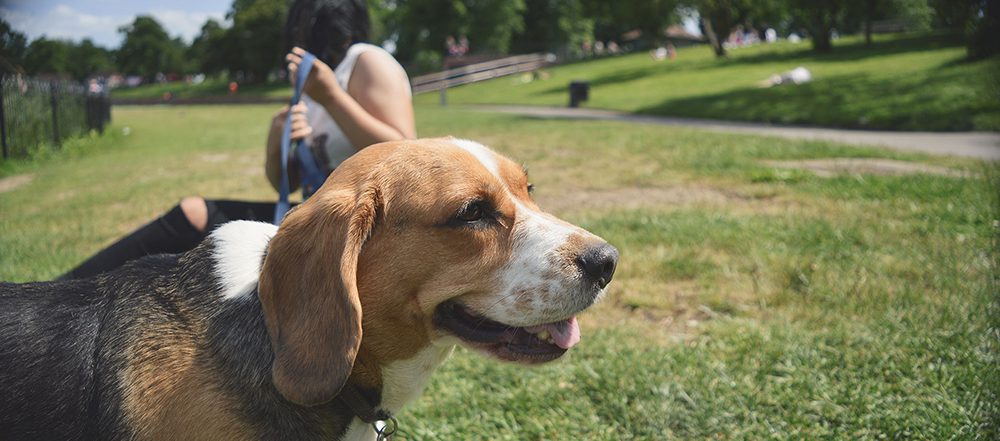
Creating Healthy Habits
Sleeping – Place the dog’s crate or bed in a safe and cozy room that can be easily cleaned, dog-proofed, and sealed off. Place several of the dog’s toys/bones in the room along with a small bowl of water. Remember, this is your dog’s “den†where they should always feel safe and happy.
Feeding – Check with First Coast No More Homeless Pets for the recommended diet based on your dog’s breed, size, age, activity level, and health. In general, we recommend feeding the dog the best food you can afford, mixing dry and wet foods for two meals a day (morning and evening). Use feeding time to train the dog to sit and remain calm, only giving food if the dog obeys.
Walking – Initially, walk the dog on a short (5-10 minutes), quiet route and avoid interaction with other people and their pets until you and the dog are comfortable and you know what to expect based on more experience.
Toys – Chew toys are not only fun for the dog, but are valuable tools to prevent problematic behaviors. By managing their “den†area to eliminate any inappropriate items that the dog could chew or eat, you are setting him/her up for success. If the dog begins chewing an inappropriate item, divert his/her attention with an acceptable chew toy or bone. Some toys, such as the KONG original, are interactive and can give your dog a much-needed mental workout. Lastly, avoid rough play with your dog for a couple of weeks.
Prevent separation anxiety – Use the den or a crate and a toy in combination with leaving for short periods and coming back several times a day, starting with your first day with the dog. Don’t make a big fuss of coming or going.
Building a Relationship
Patience – It can take some time to establish a bond with your new dog, so be patient with his/her behavior and level of training. Be sure to give the dog plenty of space to adjust and spend some time getting to know your dog’s personality and habits. It is important to build trust, so never yell or scare the dog or force close contact. If the dog misbehaves, redirect his/her behavior into something constructive like chewing a toy, playing outside, or training with treats. Remember, the dog is getting to know you as well – be a person that your dog can look up to.
Training – Physical and mental stimulation is key to training a happy and respectful dog and will also make the dog happy. It will not only strengthen your bond, but it will also teach the dog to follow house rules as he/she settles into your home. Use positive reinforcement and take a training class at your local Petco store to learn how to effectively train your dog.
If you are experiencing behavioral issues with your pet and don’t know what to do, reach out to a professional pet behaviorist or consult your local shelter for help. Larger shelters are more likely to have free resources to help you get your dog’s behavior under control.
Environment – Remember to manage your dog’s environment so that you set him up to succeed. Be proactive, not reactive. In other words, prevent inappropriate behavior from happening, and then you won’t have to correct it.
A New Cat in Your Home
Taking in a lost or homeless cat requires a lot of patience and time but can be very rewarding! Here are a few tips to make the transition easier for the cat and for you.
Before Bringing the Cat into Your Home
Before you do anything, make sure you have the supplies you need, such as a food, toys, treats, cat litter, cat litter box, cat litter scooper, flea medication, cat bed, scratching posts, etc.
Decide where food, treats, medications, etc. will be stored. If you have any other dogs or cats, place them in a different room or area of the house before you bring the new cat into the house. Keeping them separated at first is vital for their safety and well-being.
Set up a room with all of the cat’s amenities mentioned above, making sure to keep the feeding and water area as far away from the litter box as possible. This will be the cat’s room for now – not for human use – and serves as a safe haven where the cat can feel secure and hide if necessary. You can use a cat house and/or blankets to set up cozy areas for the cat. Make sure there are no inaccessible hiding spots so the cat cannot completely avoid the environment.
Introducing the Cat to Your Home
Bring the cat to his/her new room and let them have a couple hours to explore their new area without your interference. Spend time in the room every day to help the cat acclimate to your presence. While in the room you can read out loud, or call someone and just talk. This lets the cat learn the sound of your voice and become comfortable with it. If the cat approaches you for petting, do so in a very gentle, slow manner and be careful not to overstimulate. Purring is a good indicator that you are doing well!
Building a Friendship with Food
It is essential to feed your cat appropriately to build trust and affection. At first, stick to a regular feeding schedule instead of using the grazing approach. This will let the cat know that you can be trusted to feed him/her. At first, do not stay in the room while the cat eats, but when the cat seems comfortable you can sit in the room with the cat while he/she eats. Do not interfere with the cat as he/she eats – this will assure the cat that you are safe and builds trust. Most cats love wet food and treats but you can get an assortment of foods to discover what they like the best. Feed the cat their favorite food as often as possible and reap the rewards of the cat’s approval and attention.
Avoid Eye Contact
When your cat stares directly at you, do not stare them directly in the eyes. Some cats consider this to be an act of aggression and they may display unease or anger. If you accidentally lock eyes, just blink, keep your eyes closed for a few seconds, and turn your head away. Following these steps can help the cat to feel confident and safe around you.

Don’t Force Physical Contact
Your new cat will only seek contact with you once he/she trusts that you are not a threat. The process can be expedited with food once the cat is more comfortable. Place a little of the cat’s favorite food on your finger and let him/her lick it off. Doing this every so often with a skittish cat will build positive associations with you and help to break down the cat’s emotional barrier. When first petting the cat, extend your closed fist and let the cat sniff it. The cat may rub her head on your hand to let you know that she wants affection. Every cat is different and they will typically let you know what type of petting they enjoy or dislike.
Have Patience
Finally, the most important thing when bringing a new cat in your home is patience. Building trust will take time and cats can be wary and guarded. The process can take some time, but remain patient and you will end up with a wonderful companion.
Pet Introductions
Cat to Cat
Step 1 – Initial Cat Isolation
Keep the new cat and current cat separated by a door so they can hear and smell but cannot see each other. Feed both cats near the door to the room so they can smell each other while eating and develop positive associations with that smell (works with treats too.) Taking this one step further, use a clean towel to rub on the new cat’s face to capture her facial pheromones and place it near your current cat when feeding. After 2-3 days, switch the locations of the cats, letting your current cat explore the new cat’s den and vice-versa. You can also play with each of the cats near the door, building up positive associations with the scent of the other cat. Try not to let the cats see each other during this phase.

Step 2 – Visual Introduction
After about a week or two, you can try a visual introduction as long as the cats aren’t exhibiting aggressive behaviors like hissing or growling. If your new cat is feral, you may want to wait much longer until the cat feels safer and is more domesticated. To do a visual introduction, you can place a high pet/baby gate at the door entrance and continue feeding/playing as before. If one cat won’t eat her food, try moving the food dish a few feet away, or, if both cats are eating comfortably, try moving the dishes a little closer.
Step 3 – Face-to-Face Introduction
After another week or two, try getting the cats in the same room together for a supervised face-to-face meeting. If you have multiple cats, do this with only one cat at a time. It is great progress if the cats only hiss a little or ignore each other, but break up the meeting if sense one cat is harassing the other, then keep them separated and revert to the previous steps until the behavior improves. A little hostility or coldness is normal, as cats can take months or years to fully accept another cat or dog as a friend.
Cat to Dog
Step 1 – Separate Dog and Cat
When introducing a cat and dog, it is best to keep them completely separated for at least a few days or until they are both calm. Then let the cat explore the dog’s area and smells while the dog explores the cat’s area. Repeat this a few times as you “rotate†the pets in and out of each other’s areas. You may need to confine the dog to a crate or take him/her on a trip to give the cat time and space to explore.
If the dog displays obsessive or aggressive behavior with the cat such as barking, growling, or clawing at the door to the cat’s room, you may need help from a professional. Some dogs have a “prey drive,†which means they instinctively desire to chase and catch smaller animals. Without proper training, meetings between dogs with a prey drive and cats can be disastrous.
When you are away from home, be sure that both pets are securely confined so that unsupervised meetings are impossible. Once the dog is calm (or at least not obsessed with the cat) and the cat is calm, eating and using the litter box normally, you can proceed to the next step.
Step 2 – Leashed Introduction
Bring the cat and dog into the same room while keeping the dog securely leashed. Continue with this type of introduction until the dog is calm and ignores the cat and the cat is not overly skittish or defensive. If there is any fear or aggression displayed on either animal’s part, stay at step 2 longer. Continue indefinitely until both the dog and cat seem happy and relaxed around each other.
Step 3 – Allow Unsupervised Time
Unsupervised time together can occur after the cat and dog have been supervised around each other for a significant period of time (a month or so) and you are positive they will not hurt each other.
Dog to Dog
Step 1 – First Meeting at a Neutral Location
Since dogs are territorial, find a nearby park or a neighbor’s yard to make the first introduction. Each dog needs a walker equipped with a sturdy leash and tasty, bite-sized treats. Initially, walk the dogs at a distance so that they can see each other but do not feel threatened. If a dog shows aggression, redirect by rewarding a treat and using positive reinforcement in a friendly tone. Repeat this process several times until each dog seems at ease with the presence of the other.
Pay close attention to each dog’s body language. Defensive behavior includes raised hair on the back, showing teeth, long stares, and growling. Again, with these behaviors immediately and calmly redirect the dog, adding a firm “no.†As they get more comfortable, bring them closer together reward each dog with a treat for good behavior.
Once the dogs have settled down, the walker with the more docile dog should then walk closely past the other dog for an introduction. Let the dogs sniff noses and rears. If either dog growls or bares teeth, calmly redirect the dog and say “no,†then repeat the process again.
Step 2 – Take a Walk
After the initial meeting, begin taking the dogs on a walk. Take the walk slow and be patient. If they seem to be hitting it off, walk them together side by side. If they are still wary of each other, walk one behind the other, then switch roles. If all appears to be going well, you can let them interact and play with each other on the leash.
Step 3 – Coming Home
Once home, if you have a fenced in yard, you can bring them back to see how they interact in the resident dog’s territory. If they start playing, or if the resident dog walks towards you and turns his/her back on the new dog, it is a good sign that he/she is accepting of the new dog. At this point you can let them run and play with leashes dragging, closely monitoring to step in and correct any overly rough play, growling, or biting. If this occurs, separate and calm each dog, then reintroduce them calmly on the leash. Remember to always reinforce positive behaviors with treats and praise, and discourage bad behavior by redirecting and saying “no.â€
Now the dogs are tired and you can bring them into your home together. Use baby/pet gates to separate the dogs and observe how they interact with one another. Pick up all bones/treats, toys, and anything else the dogs could potentially fight over. Continue to reward good behavior with treats. Be very careful to avoid getting either dog overly excited. Feed each dog in a separate area as they can get quite defensive over their food.
Once you are sure your dogs are friendly with one-another, you can let them roam the house together under close supervision. If one or both become overly agitated, separate them and wait until each dog becomes mentally relaxed before reintroducing. Never allow the dogs to be alone together without supervision until you are certain that they are no threat to each other. When you leave the house, separate the dogs with dog/baby gates.
Take the dogs on walks frequently, as this can build comradery. Make sure to give each dog individual attention, just as you would children. This can be achieved during training sessions, walks, and outings to the pet store and dog parks.
